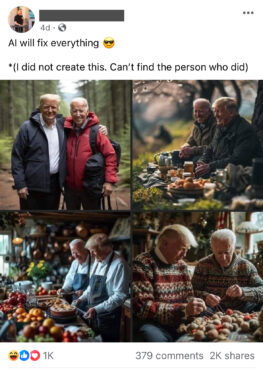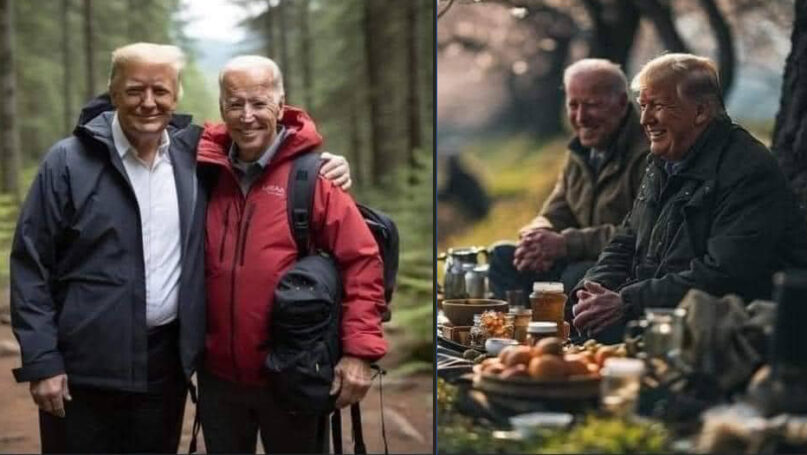(RNS) — A friend recently shared on Facebook an AI-generated image depicting four heart-warming scenes of Donald Trump and Joe Biden basking in one another’s company like two old grandpas: smiling side by side on a wooded hiking trail, an arm slung across the other’s shoulders; luxuriating on the grass under a tree before a picnic spread; cooking together in a farmhouse kitchen laden with fruit, cake, flowers and copper pots; seated together in a cozy room in front of a table of yarn, pulling inextricably at the string, engrossed, rapt, wearing color-coordinated fuzzy sweaters.
It’s the sweaters that really get you. Sure, their broad smiles, the way they appear to be sharing an inside joke at the picnic, the aprons — it’s all surreal. But those sweaters are the kicker.
My friend’s post went viral; when I shared it, it did the same. To be sure, there’s plenty of fun to be had with these crazy AI inventions. Plenty of important questions about AI to be raised, too. And this post did all that. And more.
First, my friend captioned the image with the coy disclaimer, “AI will fix everything.” This wink-and-nod was wise. Of course, AI won’t fix everything. It will likely make a lot of things worse, as was her point.

A social media post with AI-generated images of Donald Trump and Joe Biden. (Screen grab)
For one thing, as unbelievable as these images are for any number of reasons, there are certainly those out there who don’t recognize fake news as fake news. Such was the case before AI, but it’s only going to get harder now to distinguish between what is true and what is a deepfake.
This is an issue we must intentionally address in our communities, in our personal interactions and online, where these things spread the fastest. The obvious fakeness of this meme (and my friend’s caption) gently but clearly warned that these fakes are going to be out there as we get deeper into the election season. (Most will not be as benign as this one.) It’s a fun way to offer the reminder that “seeing” is not necessarily believing these days.
I recently was interviewed by the folks at AI and Faith on some of these questions. Of all the questions AI raises, the religious ones are some of the most important and interesting. One of the greatest fears about AI is the possibility that it will strip us or our faith communities of our humanity or cause us to trust one another less.
But this image of Trump and Biden as buddies demonstrates something else, something deeper and more poignant — about both AI and humanity.
Most responses I received to the image reflected the humor of it. Humor at its core arises when something deviates from what is normal or expected. If I slip on a banana peel, that’s funny because it’s not what’s supposed to happen. Jokes that work well do so because the set-up leads to the unexpected in the form of a punchline. Comedy — low or high, gentle or satirical — operates on this principle of a gap between expected and unexpected.
These images of Trump and Biden as jolly old friends, dressed in basic clothing, doing normal things, smiling and laughing, offer the unexpected on multiple levels.
We seldom if ever see either of these men look this way or act this way. Biden perhaps does so more, which only adds to the layers of the unexpected: Seeing Biden act affectionately toward his son, as he has been famously depicted as doing, is one thing; toward his sworn political enemy is another.
On the other hand, there is no context whatsoever within our social imagination for seeing Trump in the way he is depicted in the image. So the first unexpected thing the picture offers is this: these two particular men appearing this particular way, and with one another.
That leads to an unexpected thing. One of my friends commented that he found the picture strangely affecting. Others made similar observations. If we didn’t know who these two people were, we’d think this image was simply one more bad, sentimental example of unsophisticated AI art (there are clues — check out the hands and the yarn in that last scene!) depicting a Hallmark-worthy scene of two old men passing their days in a lovely retirement home.
But seeing these two particular men in these kinds of scenes taps into a sense of yearning that some of us perhaps didn’t know ran so deep: We have missed normalcy these recent years past, and we desire normalcy so very much.
If only these leaders were this human. If only we all were. These images remind us that it is — or once was — possible for political and ideological opponents to be kind, to take hikes, to play a game together, to wear soft, colorful Cliff Huxtable sweaters.
But no. Even Cliff Huxtable is fake. (To drill home the point, the man who played him, Bill Cosby, has been convicted of sexual assault and accused of more such crimes by dozens of women.) Figuring out what is true and what is a lie has been an ongoing problem, one long before the development of AI, one that continues to plague us.
But sometimes the fictions and the fakes serve to remind us of what we rightly desire — and ought to rightly pursue.






